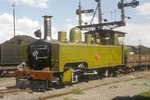 De_Aar_2ft_4-6-2T_NG4_16__KS_1344_1914__19_10_1973.jpg (149059 bytes)
De_Aar_2ft_4-6-2T_NG4_16__KS_1344_1914__19_10_1973.jpg (149059 bytes)|
The Railfaneurope.net Picture Gallery
Directory: /pix/ne/South_Africa/610mm
Last update: Mon Oct 23 00:41:05 CEST 2023
|
| SA_-_De_Aar_NG4_16 Steam in Southern Africa 1973 - 1999. 2ft gauge (610mm) 4-6-2T NG4 16 (Kerr Stuart 1344.1914), was one of seven of the type ordered by the Natal Government Railways. It spent most of its life on the Port Shepstone to Harding line in Natal, until replacement by Beyer Garratts in 1948. At that time it was sold to Rustenburg Platinum Mines for that company’s 2ft gauge system, being numbered RPM No.8. Retired in 1970 the engine was stored with many other locomotives at De Aar depot, as seen here on 19th October 1973, until being sold to Sandstone Estates in the Orange Free State. Painted blue with red number plates, NG4 16 is now a regular performer on Sandstone’s superb 2ft gauge museum railway. roger.griffiths@hotmail.com |
| SA_-_Gold_Mine_Museum Steam in Southern Africa 1973 - 1999. Johannesburg’s Gold Mine Museum was established on the former Crown Mine’s No.14 shaft, down which visitors can descend five levels (720 feet, or 220 metres), while the surface buildings housed exhibitions of all aspects of mining, refining and casting the precious metal. Around the site a 2ft gauge railway system was laid for visitors to experience steam haulage by two locomotives: an ex-South African Railways’ 0-4-0T NG 20 (Manning Wardle 1583.02) and this machine, 0-4-2T No.1 “Jack,” seen on 12th July 1981. The 0-4-2T was built for Rustenburg Platinum Mine (RPM) in 1948 (William Bagnall, Works No: 2870) one of four delivered at that time, which worked until 1980, No.1 later being sold to the museum. Today, the attraction is known as Gold Reef City Theme Park but the railway no longer exists, though “Jack” and four other locomotives were retained as static exhibits - in the writer’s opinion, a great pity. The other three Bagnall-built, ex-RPM engines have since been repatriated back to Britain. roger.griffiths@hotmail.com |
|
Steam in Southern Africa, 1973 – 1999
On the Zululand 2 foot gauge Umzinto – Ixopo - Donnybrook line, 2-6-2+2-6-2 Garratt NGG16 NG 153 arrives at Ixopo, with a freight from Highflats. Provided by Hunslet-Taylor of Germiston, South Africa (3898.1968), this engine was one of a batch of eight which were not only the last steam locomotives built for South African Railways, but they were also the last “main line” Garratts to be built in the world. The picture dates from 22 October 1976, ten years before this 2 foot gauge system was closed.
Photo and scan Roger Griffiths; roger.griffiths@hotmail.com |
|
Steam in Southern Africa, 1973 – 1999
To connect the Langkloof fruit-growing area to Port Elizabeth, a 2 foot gauge railway of no less than 285kms (178 miles), was built west from Port Elizabeth to Avontuur. In 1976 the beautifully scenic Avontuur – Assegaibos section (121kms/75m), saw at least two workings a day, each way. The trains were hauled by Class NG15 2-8-2, nicknamed the “Kalaharis” as they were originally introduced for lines in the Kalahari Desert.
On 19 October 1976, the name board for the tiny halt at Kammiebos, frames NG15 135 (Franco-Belge 2685.1953), as it passes with its freight for Assegaibos. The locomotive was first built for the Otavi Railway in South West Africa.
Photo and scan Roger Griffiths; roger.griffiths@hotmail.com |
|
Steam in Southern Africa, 1973 – 1999
South African 2 foot gauge Class NGG16, 2-6-2+2-6-2 Beyer Garratt, No. NG143 (BP 7868/1958), hurries along with the 0500 train from Ixopo to Donnybrook in Zululand, on 22 October 1976. The train is composed mostly of timber wagons and at that time traffic on all South Africa’s 2 foot gauge lines was buoyant. However, by 1986 this beautiful line, including the stretch from Umzinto to Ixopo, had been closed, the victim of a more liberal policy towards road transport.
Photo and scan Roger Griffiths; roger.griffiths@hotmail.com |